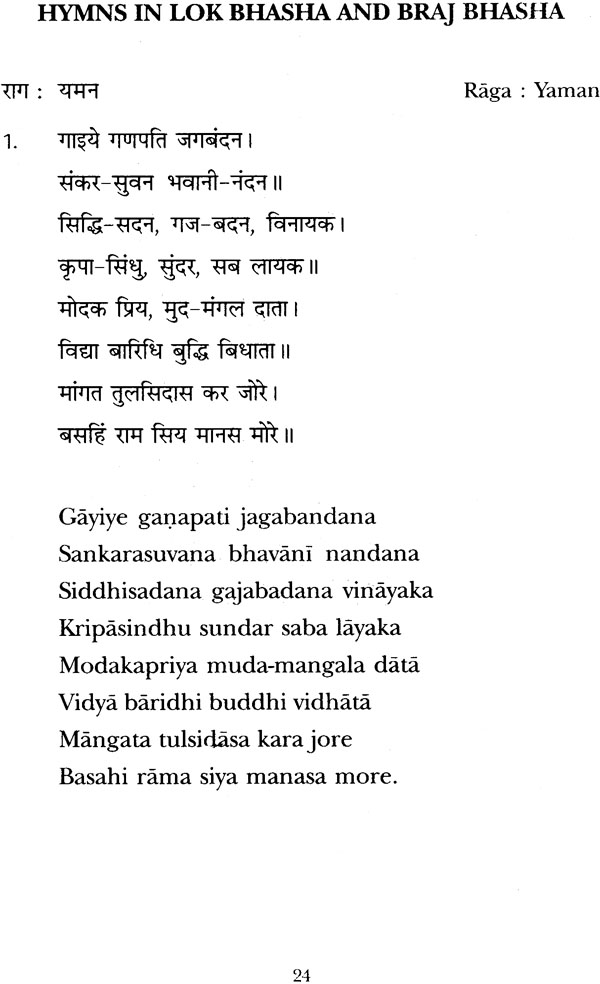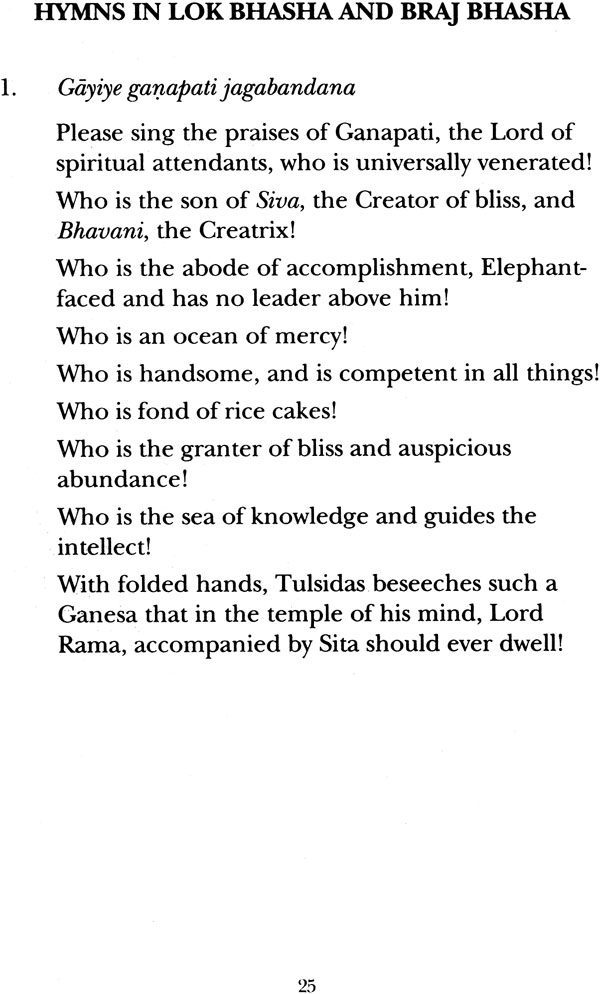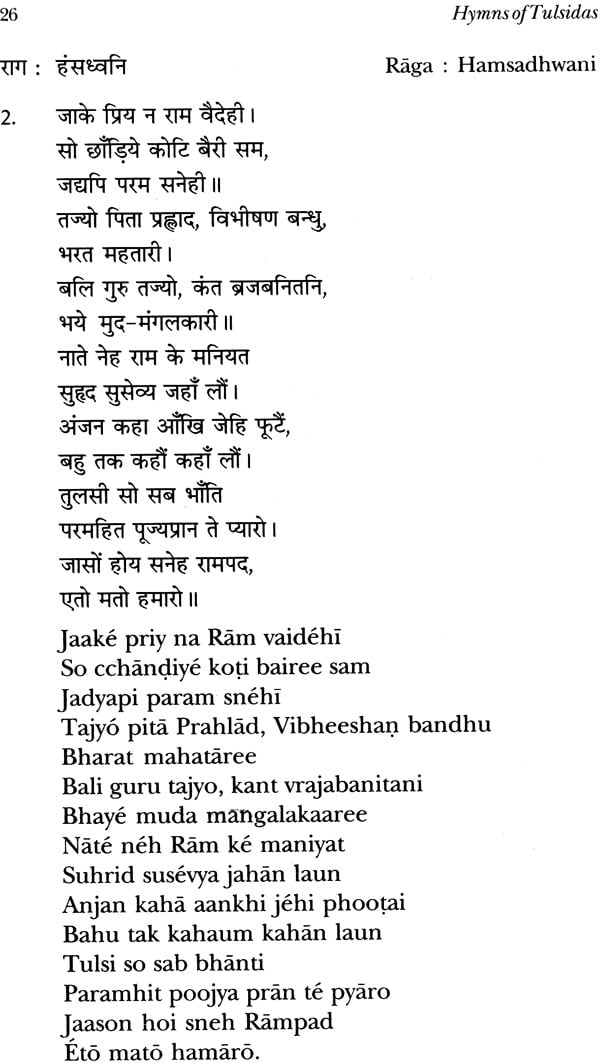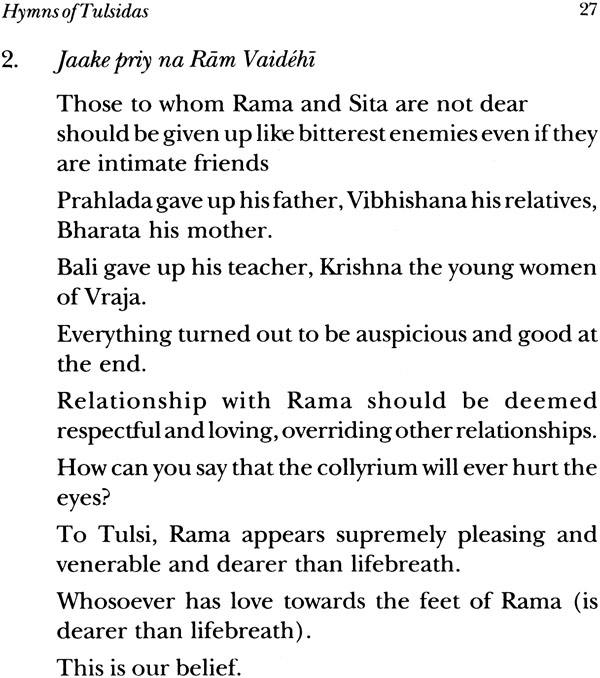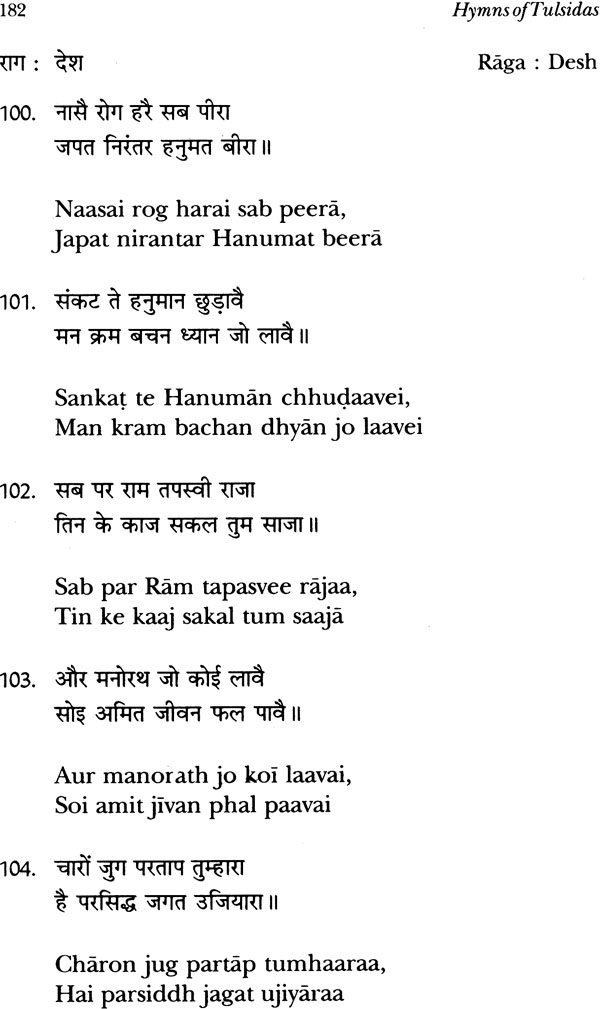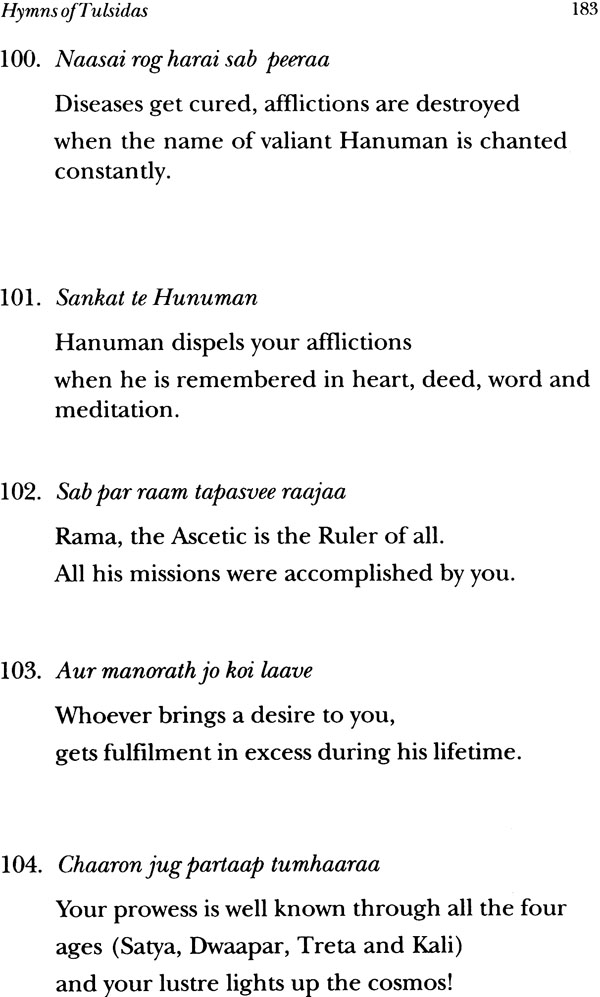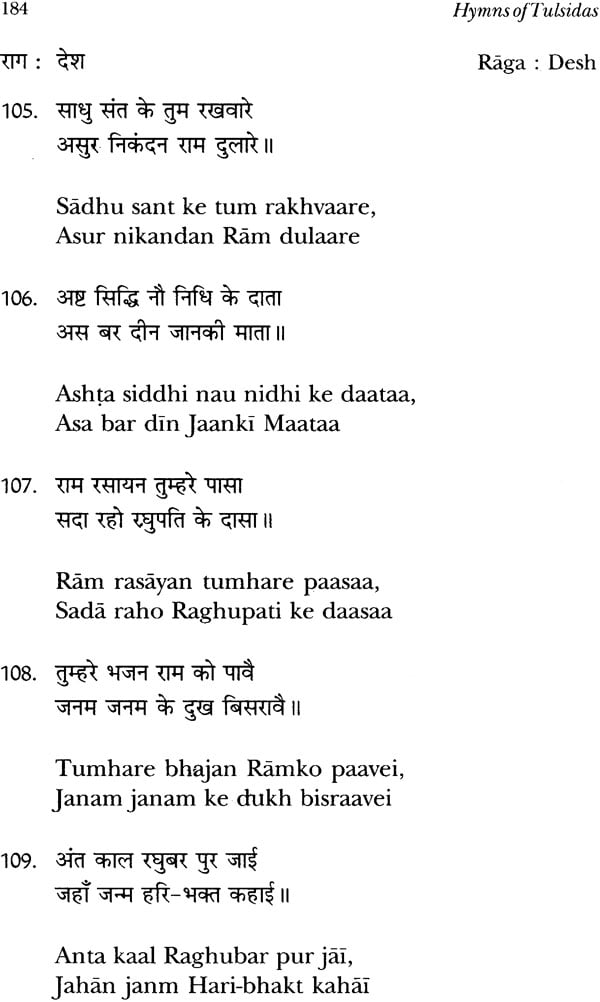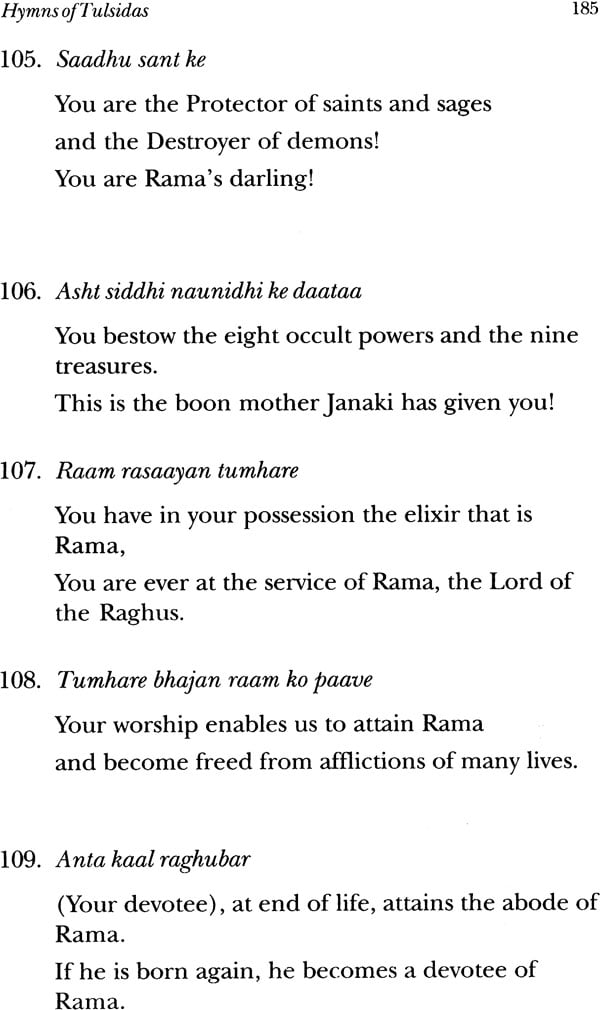
Hymns of Tulsidas ((With Original Text in Devanagari, Transliteration and English Translation))
Book Specification
| Item Code: | IDK907 |
| Author: | V.K. Subramanian |
| Publisher: | ABHINAV PUBLICATION |
| Language: | (With Original Text in Devanagari, Transliteration and English Translation) |
| Edition: | 2008 |
| ISBN: | 97881701749611 |
| Pages: | 193 |
| Cover: | Hardcover |
| Other Details | 8.9" X 5.8" |
| Weight | 400 gm |
Book Description
Hymns Tulsidas presents, probably for the first time, the popular bhajans of Tulsidas composed in Braj Bhasha and Lok Bhasha, along wit his hymns which constitute the famouse HANUMAN CHALISA, a potent prayer, sung by millions for succour and success, all in one volume.
The speciality of this volume is that it presents the texts in Devanagari script (with suitable RAGAS), along with an English transliteration and a lucid English translation so that even those who are not familiar with the dialects of Hindi used by Sant Tulsidas or the Sanskrit language will be able to understand the devotional sentiments of Tulsidas towards his favourite Deity Sri Rama and his messenger Sri Hanuman.
The songs of Tulsidas are marked by deep mysticism, total surrender to God in the manifestation of Rama and a childlike consciousness of his own shortcoming and an offering of apologia for the same.
Famous classicalsingers like Paluskar, Anop Jalota and M.S. Subbulakshmi have popularized Tulsidas's hymns among the people of India.
The Hymns of Tulsidas will not only be a valuable repertoire for all singers and music lovers but also a precious heirloom symbolising the spiritual heritage of India.
Vadakaymadom Krishna Iyer Subramanian (b. 1930, Kerala, India) is an eminent scholar, whose life mission is to present to the world the treasures of ancient India, in the fields of art, literature, philosophy and religion.
He has already translated several ancient texts into English.
These include: Saundaryalahari, Sivanandalahari, Sacred Songs of India, Maxims of Chanakya, Sri Rudraprasna and Wondrous Whispers of Wisdom from Ancient India.
As a consultant for holistic literary output covers a variety of subject ranging from astrology to art. He has been an astropalmic counselor for over 35 years.
A retired officer of the Indian Audit and Accounts Service (which he joined in 1953), Subramanian is also a reputed painter, who has heild 22 one-man shows and whose paintings (some of them in the Chandigarth Museum) have won wide acclaim from leading art critics of Indian.
Subramanian who has traveled extensively in India, now lives in the United States of America.
Of the four ways to God, laid down by Hinduism: the way to God through knowledge (Jnana Yoga), the way to God through love (Bhakti Yoga), the way to God through work (karma Yoga(, the way to God through psycho-physical exercises (Raja Yoga), Bhakti Yoga or the way to God through love is the most popular, according to Huston Smith (Author of Word's Religions), who writes in the same book:
"One of best known advocates was a sixteenth century mystical poet named Tulsidas."
To understand the life and work of Tulsidas, it is necessary to know the fundamental features of Bhakti Yoga.
The first assumption is that he who loves or worships God rejects the sense of identity with God, which the Jnani feels. The object of love has to be different from the Love.
"He who worships God Must stand distinct from Him. Only so shall he know the Joyful love of God."
Secondly, the Bhakta strives to love God with every fibre of his or her being, not for any ulterior motive but for love's sake alone.
Third, since God is Spirit, and cannot be perceived, the Bhakta needs a perceptible image of God to love.
Hinduism offers several images to choose from: Images of God as Mother, Father, Lover, Child or Master.
The image of God, chosen by the Bhakta or devotees, will be his chosen Ideal and his or her emotional approach to the love of God will determine the choice, namely, whether he or she would like to love God as a Mother, Father, Lover, Child or Master.
Different mystics have adopted different images.
Once the choice of image is made, the Bhakta develops an abiding attachment to that image. That image of God becomes the Ishta Devta, dearest deity (deemed superior to all others).
Since the human heart is attuned to loving people, the most popular image of God chosen by many would be a human incarnation of God (like Jesus, Krishna, Rama, Buddha etc.).
Tulsidas chose the image of king Rama, the human incarnation of God as his Ishta Devta. And he chose to love him as a devoted servant would love his Master.
The methodology of loving the Ishta Devata comprises: singing His praises, eulogising His majesty and glory, praying with wholehearted devotion, regarding the entire cosmos his handiwork etc.
The Bhakta lays a lot of importance on japa, or repeated changing of God's name as a means to infuse his entire being with the spirit of devotion and love for God.
The Hymns of Tulsidas can be appreciated better if one keeps in mind what has been stated in the preceding paragraphs.
Biographical details about Tulsidas are scanty.
He was probably born in 1523 A.D. at Rajapur in Uttar Pradesh. There are some accounts of his being abandoned by his parents because he was born under unlucky stars and his being adopted by a forest mendicant, who taught him the scriptures and the story of Rama.
He seems to have married and was very devoted to his wife. Because of his excessive fondness for his wife, he could not bear her absence even for a day. His wife's remark: "How passionately attached you are to me. If only you love Ram half as much you love my perishable body, you will be freed from the fears and sorrows of life" made him renounce worldly life and become a staunch devotee of Lord Rama>
He went to live his of renunciation and creativity at Varanasi, where he lived till his death in 1623.
It is good to remember that Tulsidas was a contemporary not only of Emperor Akbar and Rama Pratap Singh of Udaipur, but also of William Shakespeare.
Tulsidas wrote his magnum opus Ramachritra-manasa between 1574 and 1577.
Mahatma Gandhi remarked: "I regard the Ramayana of Tulsidas the greatest book in all devotional literature." Tulsidas's other works include: Krishna Gitavali, Vinay Patrika, Gitavali, Kavitavali, Dohavali etc. In all these, Tulsidas's devotion to Lord Rama is explicit.
Tulsidas wrote his works in Lok Bhasha and Braj Bhasha, dialects of Hindi, easily understandable by common people, through he was a scholar in Sanskrit with considerable mastery over it, as the hymns in Sanskrit presented in this volume would bear out.
Since the hymns of Tulsidas make repeated reference to the various episodes in the life of Rama, it would be useful to remember in outline the main threads of the Rama story.
Sri Rama, an incarnation of God, was born as the son of King Dasaratha of Ayodhya (also known as Kosala) of the Raghu lineage. He head three brothers: Bhrata, Lakshman and Satrughna. Dasaratha had three had three wives: Kaushalya, the mother of Lakshmana and Satrughna.
Sage Viswamitra visited King Dasaratha and requested him to send Rama and Lakshmana with him to fight the demons. Viswamitra's request was acceded to.
Walking through the forests, Rama stepped on a stone and released Ahalya from a curse.
Reaching Mithila, the kingdom of Janaka, Rama broke the great bow of Siva and married Sita, daughter of Janaka, returning to Ayodhya with his bride.
Due to manoeuvring by Kaikeyi, Rama lost his coronation and went to forest to keep his father's world, accompanied by Sita and Lakshmana. They, on his behalf.
Rama wadered in the Dandakaraya forest and killed the demon Viradha. He got the inimitable Vaishnava arrow from Sage Agastya. He was worshipped by Jatayu, the great eagle (whom he later cremated) and stayed for a while in Panchavati.
He slew the evil Mareech, who assumed the from of the golden beer and searching for Sita, stolen by the ten-headed Ravana the evil demon King of Lanka, met the tribal woman Sabari, on whose advice came to the bank of the Pampa river and with the help of Hanuman, son of Anjani, made friends with Sugriva, the son of Sun and slit the body of Vali, who had stolen Sugriva's wife.
Staying with Sugriva, Rama gave his ring to Hanuman, son of Wind, who went in search of Sita, met her Lanka and after showing it to Sita, brought it back to Rama.
Vibhishana, brother of Ravana, sought refuge in Rama on the seashore.
Rama built the Sethu bridge on the ocean with the help of the monkeys, reached Lanka and killed Ravana, the ten-headed demon King.
He returned to Ayodhya, accompanied by Sita, who was purified by fire and had the coronation at Ayodhya with pomp and splendour.
Apart from the episodes in the Ramayana, in which Rama displays his divinity, nobility, compassion and protects those who seek refuge in him, irrespective of their social status or genre of being, all of which Tulsidas extols with zeal and fervour, he also makes several reference in his hymns to the various episodes of the Krishna incarnation like protecting the Pandavas and saving Draupati from disgrace by the disrobing attempted by the evil Dussasana.
There is also reference, in Tulsi's hymns, to episodes connected to Vishnu, whose incarnations Rama and Krishna are. Examples are the Prahlada episode, the Gajendransoksha episode, the story of Ajamila etc.
Tulsidas's deep and extensive knowledge of the scriptures and the Puranas is evident in these references.
In the hymns of Tulsidas we find mention of certain terms like Kalpataru, the wish-fulfiling tree, Kamadhenu, the wish-granting holy cow, and the Chantamani stone which fulfils all desires.
People in India are familiar with these terms but some explanation of the mythological background of these terms might be necessary for foreign readers.
According to Agni Purana, Kalpataru or Kalpakarishna, the celestial tree which has the power of grating all wishes, was one of the wonderful things which came out milky ocean was churned by the angles and the demons.
Similarly, Kamadhenu, the celestial cow, is considered to have divine power to fulfil any wish. She is deemed the mother of all cows in the world.
Chintamani is a diamond which came out, like Kalpakavriksha, at the time of churning of the milky ocean by angels and demons.
The Puranas of India are replete with myriad stories related to various deities. It is difficult to elaborate on them in this brief introduction. But one running theme in India's myths and legends may be mentioned: God manifests in many ways to destroy evil and uphold righteousness.
Tulsidas's beloved Rama is one such incarnation of God who destroys evil demons, protects the righteous and saved all those who seek refuge in Him from the sorrows of the phenomenal world.
I am proud to present the Hymns of Tulsidas, dripping with devotion to God, to my readers scattered all over the globe.
| Acknowledgements | 15 | |
| Introduction | 17 | |
| | ||
| | ||
| 1. | Gaayiye ganapati jagabandana | 24 |
| Raga: Yaman | ||
| 2. | Jaake priy na raam vaidehi | 26 |
| Raga: Hamsadhwani | ||
| 3. | Raghuvar tum ki meree laaj | 28 |
| Raga: Maru Behag | ||
| 4. | Nainam men siyaraam bsojee mere | 30 |
| Raga: Lalat | ||
| 5. | Mamtaa tu na gai mere man te | 32 |
| Raga: Kalavati | ||
| 6. | Bhaj man raamcharan sukhadaayee | 34 |
| Raga: Bhairavi | ||
| 7. | Tu dayalu, deen haum, tu daani, haum bhikhaari | 36 |
| Raga: Desh | ||
| 8. | Bhaj raghuveer syaam jugal charan | 38 |
| Raga: Bahar | ||
| 9. | Thumak chalat raamachandra baajat paijaniyaan | 40 |
| Raga: Jenjoti | ||
| 10. | Jaanakeenaath sahaay kare jab | 42 |
| Raga: Kalyan Jenjoti | ||
| 11. | Ko no krodh nirdahyo, kaam bas kehi nahim keenho | 44 |
| Raga: Bilawal | ||
| 12. | Aasram baran kali bibas bikal bhaye | 46 |
| Raga: Todi | ||
| 13. | Ko oo kahen karat kusaaj dagaabaaj bado | 48 |
| Raga: Kedara | ||
| 14. | Raam haim matu pitaa guru bandhu | 50 |
| Raga: Baagesree | ||
| 15. | Taulom lobh, laalup lallaat laalachee labaar | 52 |
| Raga: Vibhas | ||
| 16. | So janani so pitaa soi bhaai so bhagini | 54 |
| Raga: Desh | ||
| 17. | Main hari, patit-paavan sune | 56 |
| Raga: Peelu | ||
| 18. | Eesan ke ees, mahaaraajan ke mahaaraaj | 58 |
| Raga: Khamaaz | ||
| 19. | Meet baali-bandhu, Poot, daskndh-bhadhu | 60 |
| Raga: Saurashtra | ||
| 20. | Silaa-saap, guh geedh ko milaap | 62 |
| Raga: Lalat | ||
| 21. | Raam maatu bandhu sujan guru poojy param hit | 64 |
| Raga: Poorvi | ||
| 22. | Kaahe ko phirat moodh man dhaayo | 66 |
| Raga: Behag | ||
| 23. | Siyaraam-saroop agaadh anoop bilochan- meenan ko jalu hai | 68 |
| Raga: Malkauns | ||
| 24. | Yah binati raghuveer gusaai | 70 |
| Raga: Dhanaasree | ||
| 25. | Naam mahaaraaj ke nibaah neeko keejai ur | 72 |
| Raga: Soohi | ||
| 26. | Kabhunk haum yahi rahaungo | 74 |
| Raga: Asaveri | ||
| 27. | Dev! Doosaro kaun deen do dayaalu | 76 |
| Raga: Gauda-Sarang | ||
| 28. | Kahukehi kahiye kripaanidhe! Bhavajanit vipti ati | 78 |
| Raga: Nata | ||
| 29. | Kahaan jaaoon kaaso kahaun aur thaur na mere | 80 |
| Raga: Bahar | ||
| 30. | Raam japu raam japu raam japu baavre | 82 |
| Raga: Bhairav | ||
| 31. | Kripaasindhu! Jan deen duvaare daadi na paavat kaahe | 84 |
| Raga: Desh | ||
| 32. | Kabhoon tau kar-saroj ragunaayak! | 86 |
| Raga: Durga | ||
| 33. | Raam raam, ratu raam raam ratu, raam raam, japu jeehaa | 88 |
| Raga: Kanhara | ||
| 34. | Kaajukaha nar tanu dhari khaariyo | 90 |
| Raga: Dhanaasree | ||
| 35. | Kaahe ko phirat man karat bahu jatan | 92 |
| Raga: Kalyaani | ||
| 36. | Mere raavariye jati raghupati hai bali jaaoon | 94 |
| Raga: Lalat | ||
| 37. | Kaahe rasanaa, raam na gaavahi? | 96 |
| Raga: Durga | ||
| 38. | Paavan prem raamcharan kamal janam laahu param | 98 |
| Raga: Bhairavi | ||
| 39. | Jaisaa haun taiso raam raavarau jan jani parihariye | 100 |
| Raga: Kedara | ||
| 40. | Hari naam base hari naam base jinke hirday hari naam base | 102 |
| Raga: Yaman | ||
| 41. | Kabhu man visraam na maanyo | 104 |
| Raga: Brindavana Sarang | ||
| 42. | Manorath man ko ekai bhaanti | 106 |
| Raga: Poorvee | ||
| 43. | Kabhoon kripaa kari raghuveer! Mohu chitaiho | 108 |
| Raga: Kanada | ||
| 44. | Bharoso jaahi doosro so karo | 110 |
| Raga: Kalyaan | ||
| 45. | Jaaoon kahaan taji charan tumhaare | 112 |
| Raga: Dhanaasree | ||
| 46. | Asi kacchu samujhi parat raghuraayaa | 114 |
| Raga: Hamsadhwani | ||
| 47. | Jaag jogee jagam jati jammaatee dhyaan dharai | 116 |
| Raga: Desh | ||
| 48. | Ab laum nasaanee ab na nasaihaum | 118 |
| Raga: Bilawal | ||
| 49. | Kisabee kisaan kul banik bhikhaaree bhaat | 120 |
| Raga: Soohi | ||
| 50. | Bhali bhaarat bhoomi, bhale kul janmu | 122 |
| Raga: Khamaaz | ||
| 51. | He hari, kavan janatbhram bhaagai | 124 |
| Raga: Vilas | ||
| 52. | Jag jaanchiye kou na, jaanchiye jau jiyjaanchiye | 126 |
| Raga: Gauri | ||
| 53. | Bishayaa paranaari nisaa-tarunaai | 128 |
| Raga: Bikas | ||
| 54. | Jaake bilokat lokap hot bisok | 130 |
| Raga: Peelu | ||
| 55. | Sunu kaan diye nit nem liye | 132 |
| Raga: Kedar | ||
| 56. | Reeti mahaaraaj kee nevaajiye | 134 |
| Raga: Bahar | ||
| 57. | Naahin bhajiye jog biyo | 136 |
| Raga: Naatak | ||
| 58. | Naam kyon basaum jam-nagar tere | 138 |
| Raga: Jenjoti | ||
| 59. | Jad panch milai deh karee | 140 |
| Raga: Bagesree | ||
| 60. | Janamyo jehi joni anek kriyaasukh laagi karee | 142 |
| Raga: Durga | ||
| 61. | Ruchir rasanaa tu raam raam kyon na ratat | 144 |
| Raga: Bhairavi | ||
| 62. | Jaati ke sujaatike, kujaati ke petaagi bas | 146 |
| Raga: Poorvee | ||
| 63. | Sut, daar, agaar, sakhaa, parivaarbiloku | 148 |
| Raga: Peelu | ||
| Hymns In Sanskrit | ||
| 64. | Sri raamchandra kripaalu bhaja man harana bhavaya daarunam | 150 |
| Raga: Yaman | ||
| 65. | Yanmaayaavasavarti visvamakhilam | 152 |
| Raga: Bhoopaal | ||
| 66. | Prasannataam yaa nagataabhishekastathaa | 154 |
| Raga: Kapi | ||
| 67. | Neelaambujasyaamala komalaangam | 156 |
| Raga: Suddhasaveri | ||
| 68. | Saandraanandappayoda saubhagatanum | 156 |
| Raga: Sree | ||
| 69. | Brahmaabhdhi samubhavam | 160 |
| Raga: Malkauns | ||
| 70. | Saantam saavatamaprameyamanagham | 162 |
| Raga: Yaman-Kalyan | ||
| 71. | Naanya sprihaa raghupat hridaye asmadeeye | 164 |
| Raga: Neelambari | ||
| 72. | Raamam kamaarisevyam bhavabhaya haranam | 166 |
| Raga: Hamir Kalyan | ||
| 73. | Kekee kanthaabha neelam | 168 |
| Raga: Madhyamavati | ||
| Sri Hanuman Chalisa | ||
| 74. | Sree guru charan saroj raj | 170 |
| Raga: Lalat | ||
| 75. | Buddhiheen tanujaanike | 170 |
| Raga: Lalat | ||
| 76. | Jai hanuman jnaan gun saagar | 172 |
| Raga: Desh | ||
| 77. | Ram doot atulitbal dhaamaa | 172 |
| Rama: Desh | ||
| 78. | Mahaaveer bikram bajrangee | 172 |
| Raga: Desh | ||
| 79. | Kanchan baran biraaj subesaa | 172 |
| Raga: Desh | ||
| 80. | Haath bajr au dhwajaa biraaje | 172 |
| Raga: Desh | ||
| 81. | Sankar Suvam Kesari nandan | 174 |
| Raga: Desh | ||
| 82. | Vidyaavaan gunee atichaatur | 174 |
| Raga: Desh | ||
| 83. | Prabhu chritr sunibe ko rasiyaa | 174 |
| Raga: Desh | ||
| 84. | Sooksham roop dhari asur samhaare | 176 |
| Raga: Desh | ||
| 85. | Bheem roop dhari asur samhaare | 176 |
| Raga: Desh | ||
| 86. | Laay sajeevan lakhan jiyaaye | 176 |
| Raga: Desh | ||
| 87. | Raghupati keenhee bahut badhaari | 176 |
| Raga: Desh | ||
| 88. | Sahas badan tumharo jas gaavaim | 176 |
| Raga: Desh | ||
| 89. | Sanakadik brahmaadi nuneesaa | 176 |
| Raga: Desh | ||
| 90. | Jam kuber digpaal jahaan te | 178 |
| Raga: Desh | ||
| 91. | Tum upkaar sugreevahim keenhaa | 178 |
| Raga: Desh | ||
| 92. | Tumharo mantr bibheeshan maanaa | 178 |
| Raga: Desh | ||
| 93. | Jug sahasrajojan par bhaanu | 178 |
| Raga: Desh | ||
| 94. | Prabhu mudrikaameli much maahi | 178 |
| Raga: Desh | ||
| 95. | Durgam kaaj jagat ke jete | 180 |
| Raga: Desh | ||
| 96. | Rama duwaare tum rakhavaare | 180 |
| Raga: Desh | ||
| 97. | Sab such lahai tumhaaree sarnaa | 180 |
| Raga: Desh | ||
| 98. | Aapan tej samhaaro aapai | 180. |
| Raga: Desh | ||
| 99. | Boot pisaach nikat nahim aavai | 180. |
| Raga: Desh | ||
| 100. | Naasai rog haraisab peeraa | 182 |
| Raga: Desh | ||
| 101. | Samkat tem hanuman cchudaavai | 182. |
| Raga: Desh | ||
| 102. | Sab par raam tapasvee raajaa | 182 |
| Raga: Desh | ||
| 103. | Aur manorath jo koi laavai | 182 |
| Raga: Desh | ||
| 104. | Chaaron jug partaap tumhaaraa | 182 |
| Raga: Desh | ||
| 105. | Saadhu sant ke tum rakhvaare | 184 |
| Raga: Desh | ||
| 106. | Asta siddhi nau nidhi ke daataa | 184 |
| Raga: Desh | ||
| 107. | Raam rasayan tumhare paasaa | 184 |
| Raga: Desh | ||
| 108. | Tumhare bhajan raam ko paavai | 184 |
| Raga: Desh | ||
| 109. | Ant kaal raghubar pur jaayee | 184 |
| Raga: Desh | ||
| 110. | Aur devataa chit na dharai | 186 |
| Raga: Desh | ||
| 111. | Sankat katai mitai sab peeraa | 186 |
| Raga: Desh | ||
| 112 | Jai jai jai hanuman gosaai | 186 |
| Raga: Desh | ||
| 113. | Jo sat baar path kar koi | 186 |
| Raga: Desh | ||
| 114. | Jo yah padhai hanuman chaleesaa | 186 |
| Raga: Desh | ||
| 115. | Tulseedaas sadaahari cheraa | 188 |
| Raga: Desh | ||
| 116. | Pavan tanay samkat haran mangal moorti roop | 188 |
| Raga: Lalat | ||
| Alphabetical Index of Hymns | 191 |
